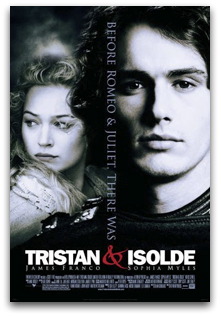Tristan & Isolde
01/23/2006 12:08 Filed in: Movies and Television

The story is basically one of forbidden love which is why the promoters have used the tagline, "Before Romeo & Juliet, There Was Tristan & Isolde." Well, that's true, and both stories are essentially tragedies, but that's where comparisons end. The aspect of forbidden love in this movie centers around Tristan's duty to deliver the woman he loves, Isolde, to his uncle, King Mark of Cornwall. This is a world of politically arranged marriages so Isolde, daughter of the Irish king, cannot simply refuse to marry Mark. She is bound to do so out of a sense of duty to her place and the supposed peace between the warring tribes that such a union will bring.
Now, if you're familiar with the original story, and you're expecting Tristan to rescue Isolde from a dragon and the two of them to fall under the spell of a witch's love potion, you will be disappointed. This telling of Tristan & Isolde is very much a "demythologized" version much like what First Knight was to the King Arthur legend or what The 13th Warrior was to Beowulf. I teasingly commented to Kathy on the way out of the theater that I was somewhat disappointed that there was no dragon. "There did not need to be a dragon in that movie! It would not have fit!" she exclaimed somewhat indignant that I would even make the suggestion.
Tristan is played by James Franco (Freaks & Geeks, Spider-Man). Franco is quite a good actor and definitely one we'll continue to see for some time. His trademark seems to be that saddened/hurt/betrayed/intensely introspective look that he carries throughout most of the movie, especially the second half. In the poster that I included above, he's almost smiling, but that's about the happiest you'll see him in this role. Sophia Miles plays Isolde (pronounced like it looks, by the way, but with a silent e). I had only seen Miles in Underworld before I saw this movie but she gives a fairly convincing performance. Perhaps the best performance was delivered by Rufus Sewell (Dark City, A Knight's Tale) who plays Tristan's Uncle, Lord Mark (later King Mark). Sewell is an extremely talented actor, but I'm so used to seeing him in roles as the villain that I assumed Mark was a bad guy in the first twenty or so minutes of this version of the tale. He's not.
I've heard very little buzz surrounding Tristan & Isolde. In fact, I never have seen a trailer on television (but I don't watch as much television as I used to), but rather first discovered the film on the Quicktime Movie Trailer website. I was interested in seeing it because of its literary connections and I also tend to enjoy period pieces. Having said that, I must confess that while the movies i good, it's not great. And I don't think it's done all that well at the box office. Indeed, it may be a film in search of an audience. Pardon my blatant sexist generality here, but with a tagline like "Before Romeo & Juliet, There Was Tristan & Isolde" you would think that the movie is targeting primarily a female audience. But When Harry Met Sally, this movie is not. There are a number of extremely violent scenes which is the primary reason it garners a PG-13 rating. I suppose, however, that guys out there could suggest this movie for a date night to look romantic and then later give a "who knew?" shrug during the fiercer battle scenes.
Tristan & Isolde is rated PG-13 "for intense battle sequences and some sexuality." There is no real nudity involved--lots of shots from the shoulders and up during the love scenes--but there is more blood than recent fare in movies such as the Lord of the Rings trilogy.
One last comment... I didn't know this until yesterday after looking up some of the history behind the original story, but evidently, Tristan may actually have been based on a real person in history. From the article in the Wikipedia:
A standing gravestone called the "Tristan Stone" near Fowey in Cornwall says simply enough in Latin 'Drustanus Hic Lacit Cunomori Filius' (Drustanus lies here, the son of Cunomorus). Interestingly, Cunomorus is the Latin name of King Mark of Cornwall, who in legend was Tristam's uncle and Iseult's husband ... Tristan may in fact have been a Pictish prince under a British King ... Under this explanation, the question arises of how the gravestone can be explained. One suggestion is that he could have been adopted into the family of Mark of Cornwall, which was an attested practice in Roman law.
Interesting...









